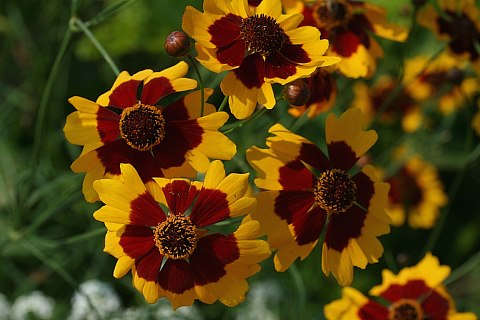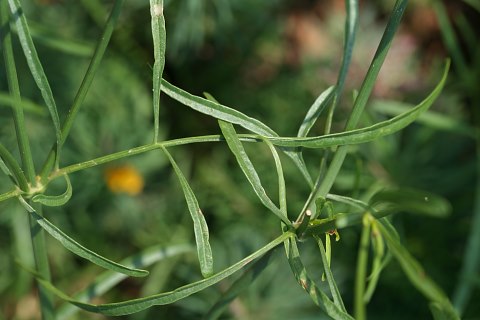Description: This is an annual wildflower about 1½–3' tall that branches occasionally. The stems are medium green and glabrous. The leaves are up to 6" long and 4" across (excluding the petioles); they are simple- or double-pinnate, medium green, and glabrous. The leaflets (or lobes) are up to 2" long and less than ¼" across; they are linear, linear-lanceolate, or linear-oblanceolate. The upper stems terminate in flowerheads that individually span about 1-2" across. Each flowerhead has 6-12 ray florets that surround numerous disk florets. The ray florets are reddish brown toward the center of the flowerhead, but become golden yellow toward their tips; less often, they may be reddish brown throughout. Each ray floret becomes wider toward its tip, which is divided into 3 large teeth. The tiny disk florets have corollas that are reddish brown and tubular in shape; each corolla has 4 tiny teeth along its upper rim. The base of each flowerhead is surrounded by glabrous brown bracts (phyllaries); the outer bracts at the very bottom of the flowerhead are small and triangular in shape, while the inner bracts are much larger in size and ovate in shape. The blooming period occurs from mid-summer to early fall and lasts about 1-2 months. The fertile disk florets are replaced by small achenes that lack tufts of hair. The root system is fibrous. This wildflower reproduces by reseeding itself.

Cultivation:
Preferred growing conditions consist of full sun and moist to mesic
sandy soil. However, other kinds of soil are readily tolerated,
including those that contain loam, clay-loam, or some gravel. Depending
on the cultivar or local ecotype, there is considerable variability in
the size of flowerheads and the height of plants.
Range & Habitat:
Plains Coreopsis has naturalized in scattered locations throughout
Illinois, where it is generally uncommon (see Distribution
Map). This introduced species is native to the region of the
Great Plains in North America; most local populations in Illinois are
descendants of plants that have escaped from cultivation. Habitats
include sand prairies, rocky glades, areas along railroads, roadsides,
and waste areas, particularly where the soil is rather barren. This
species is cultivated in gardens because of the attractive flowerheads.
Faunal Associations:
The flowerheads of Coreopsis spp.
provide nectar and pollen to a wide variety of insects, including
long-tongued bees, short-tongued bees, wasps, flies, butterflies,
skippers, and beetles. The caterpillars of the moths Synchlora
aerata (Wavy-Lined Emerald) and Tornos
scolopacinarius (Dimorphic Gray) feed on the foliage of Coreopsis
spp. and similar plants. Another insect that feeds on the
foliage of these species is the leaf beetle, Calligrapha
californica, which has been found specifically on Plains
Coreopsis.

Photographic
Location:
A flower garden at the Arboretum of the University of Illinois in
Urbana, Illinois.
Comments:
During the blooming period, Plains Coreopsis produces showy flowerheads
in abundance. This species can be distinguished from other wildflowers
by the ray florets of its flowerheads, which are yellow-maroon or
maroon (reddish brown). Sometimes the ray florets of Rudbeckia
hirta (Black-Eyed Susan) and Rudbeckia fulgida
(Orange Coneflower) are partially maroon, but their ray florets have
narrow tips that lack large teeth. Furthermore, the leaves of these
latter species are not pinnately divided, unlike those of Plains
Coreopsis. Other Coreopsis spp. in Illinois are
perennial plants; they have ray florets that are yellow throughout.
Another common name of Coreopsis tinctoria is
Golden Coreopsis.